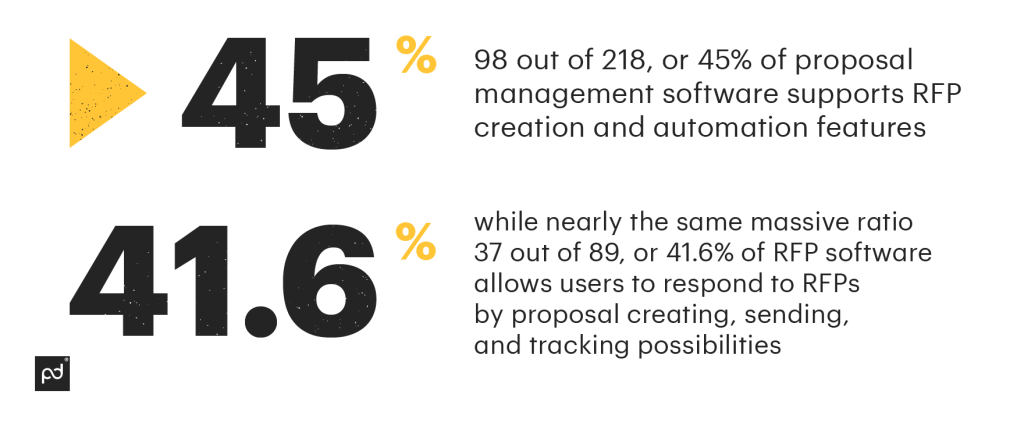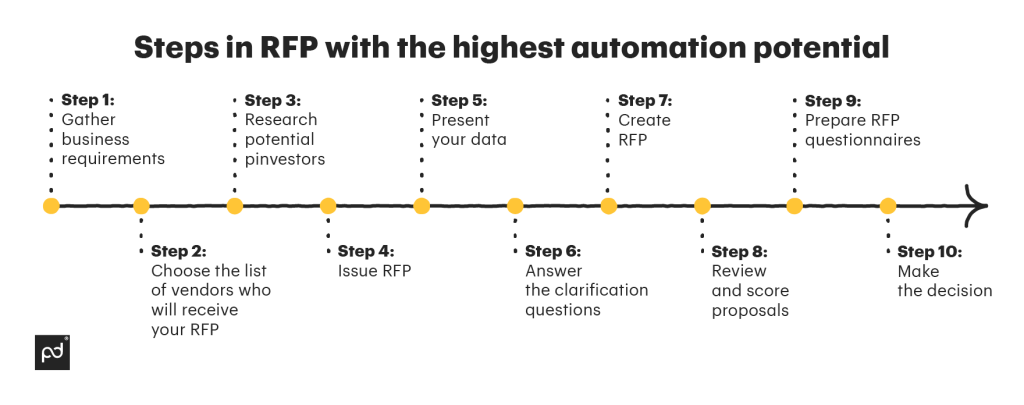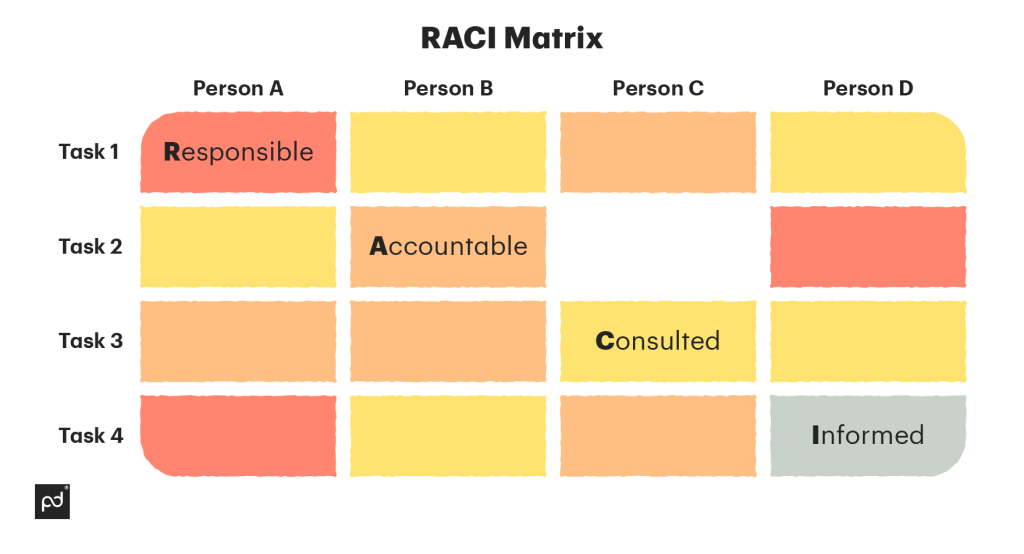Preparing requests for proposals (RFPs) is a business routine that’s highly important for successful procurements.
This process consumes the most valuable and expensive labor resources of your procurement staff.
For the other party, the RFP responding process is tied to the same routine and causes many of the same issues.
A typical RFP mostly consists of ready-made content pieces like corporate contact information, answers to fairly standard questions, or descriptive information about your business.
These pieces remain unchanged from one RFP to another.
So, a large majority of content for each request for proposal can be successfully recycled rather than being prepared from scratch for each new RFP.
This reuse is possible thanks to various RFP automation software tools.
Different tools act in different ways but with quite similar outputs. In the article below, we’ll:
- Define what RFPs are, what request for bid is, RFP automation, and RFP tools
- Learn about AI and knowledge management as the two main sources of RFP automation
- Discover the benefits of RFP automation
- Learn the best way possible to automate the steps of RFP management
- Offer ways to avoid errors in RFPs
RFP, request for bid, RFP automation, and RFP tool definitions
Before delving deeper into the topic, let’s сlarify the terms we’ll use frequently in our article.
- A request for proposal (RFP) is a document issued by the buyer’s procurement team (the government is often in this buyer’s role as well) for the potential sellers or contractors, asking them to make their offers following the requirements described in the RFP text. Such documents cover various questions that must be answered, including information about previous experience, prices, staff required, detailed scope of work, terms of compliance, etc.
- A request for a bid can be called a lightweight version of an RFP. Covering much less sophisticated goods and services, the bid requests usually focus on a price only.
- RFP automation, in general, is a set of measures aimed at reducing human intervention during the creation, management, and evaluation of RFPs.
- In a narrow sense, RFP automation is a cloud-based B2B toolset used for automating the request for proposal management.
- This toolset is often called “a tool,” or an RFP tool. The popularity of such tools, along with their level of efficiency, has risen significantly in the last few years.
What’s the difference between RFP vs proposal management software?
RFP software is very similar to this neighboring category, proposal management software.
While the RFP automation tools are aimed at speeding up the procurement routine on the buyer’s side, proposal management solutions are designed to help the selling party do very much the same.
Both software categories have various intersecting features, as well as tools, acting in similar ways but applied differently.
For example, with RFP tools, AI analyzes procurement requirements, converts them into questions, and then forms questionnaires for further proposals.
In the case of proposal management software, its AI engine analyzes the questions from RFP, searches the knowledge base for answers, and assigns the unanswered ones to the related subject matter experts.
Moreover, some systems combine RFP and proposal management features, which makes them full-fledged members of both categories.
A good example of such a combination is PandaDoc.
The software allows for creating, sending, and tracking both RFPs and proposals, as well as many other types of documents.
One more interesting but potentially confusing thing:

Further muddying the waters, there is also a significant mess in the terms used by different vendors and media in their publications.
Some of them consider these both types of software as a single entity.
For example, Adobe’s position on this matter is that RFP software is equally aimed at both buyers and sellers.
It is offering the buyers all that’s needed to form and create RFPs from templates; for sellers, they can apparently use the same software for creating the RFP responses using templates, sending, and then tracking them.
AI and smart content recycling: the main sources of RFP automation
Two main principles help today’s RFP automation tools streamline the process — AI-based content analysis and knowledge base, or content reuse.
And by far the most impressive results can be achieved only when both these tools work in unison.
The AI-powered content analysis starts with a gathering and review of requirements for a specific procurement episode.
The tool scans all the data included in the requirements documentation or any other allowed sources, then forms a list of questions that should be answered by the second party in their proposal.
Then, it’s time for smart content recycling.
The goal is to choose the proper RFP template from the library, add this questionnaire, and complete your request for proposal with the standard descriptive information we mentioned at the beginning.
All the standard data is in place and saved, stored for instant usage again, no matter how many times it was used previously.
The data is added with almost no effort; the worst thing your staff can expect is having to make some manual corrections in the visual editor.
There are several not-as-crucial but nonetheless important features RFP automation tools should include the following features.
1. Collaboration
Teamwork is essential in RFP creation and response.
Allowing your staff to work simultaneously on their own tasks or questions means much higher overall performance.
If we speak about collaboration with the second-party staff, it’s important not to confuse them with an unfriendly UI.
2. Analytics
Running blind is never a good idea.
You must clearly understand what you do, how efficient it is, and which way you can act to best improve results.
3. Integrations
RFP management is a part of a bigger bunch of very important activities.
Third-party software integration features allow your staff to export and import data, add valuable tools your RFP automation software may lack, and embed your RFP management process into your other sales or procurement processes.
4. Grammatical errors checking tool
If your documents contain mistakes, it is highly likely your chances for success will be lowered.
5. Alerts and notifications
Stay informed when the other party opens your document or a deadline is approaching.
6. Tracking and audit trails
The feature makes it possible to track when your documents are sent to anyone else. The trail feature allows you to control many different parameters.
Benefits of RFP automation
Let’s speak a bit about the motivation for using such tools, and why adoption is so much better than remaining stuck in the Stone Age of 10 or 20 years ago.
The benefits of RFP automation are as follows:
1. Faster process
The issuing speed with RFP automation tools increases multifold.
As a result, your team can process much more requests within the same period and effort.
2. Happier team members
Reducing the number of chores, RFP automation frees up time for more exciting, creative, and challenging tasks.
This makes your staff’s job much more interesting, which helps them feel happier.
3. Increased profitability
The faster and better you process your RFPs or proposals, the more chances you’ll have to close your deals with better conditions.
This translates to more revenue and higher profits.
In addition, your staff, enhanced with an RFP automation tool, will work at much higher levels of productivity, which means fewer people (and salaries paid) for the same amount of work.
4. Transcended limits
Non-automated RFP management is highly labor-intensive and often a long process; as such, management teams have limited resources for growth.
Implementing automation naturally makes magic happen, allowing teams to take a huge leap forward almost instantly.
5. Higher consistency, fewer errors
Thanks to automation, there is much less room for errors to remain.
With centralized data storage and standardized templates, it’s possible to reduce the inconsistency to near-zero status.
Signs that you need to automate your RFP management
In almost every case, automation wins versus manual work. But sometimes teams that lack automation tools consider their situation as normal or acceptable. In such environments, it’s important to look in from the sidelines and identify the issue(s) by some of the clear signs described below.
1. It takes too long to complete each RFP
When we speak about contracts worth millions, each request or proposal is always a masterpiece.
These documents must cover all the aspects of furthering the deal, including risks and conditions.
The preparation process consists of dozens if not hundreds of different small subtasks which must be coordinated with each other.
According to the research conducted by Govloop, even two months spent on each RFP, from mailing to award, doesn’t seem like too much time.
Thinking this way is surely ill-advised, as such a long preparation lifecycle complicates the management process with new challenges like staff onboarding and offboarding.
Just imagine: you’ve started crafting a document with a colleague but then they left the job the following month before the document was complete.
Or, something force majeure has happened during the process, ruining all the previous efforts.
That’s why even if you think that two months of crafting every single document isn’t a big deal, think twice.
Your situation may worsen at any moment, and the longer you develop your documents on average, the more vulnerable your department is to these unpleasant changes.
2. You’re forced to simplify your RFPs to meet deadlines
Due to the highly comprehensive and complex nature of proposal-related documents, RFPs sometimes require huge timeframes to be finished.
But what’s the best plan forward when your resources are severely limited, or the team consists of just one person, and/or the most advanced tool at your disposal is Google Sheets?
You can’t simply postpone the deadline to next year, right?
Most often, the solution is to make your work less comprehensive by simplifying the most labor-intensive parts.
For example, once the answer to a certain question is really difficult or impossible to obtain, it makes sense to not answer it at all, for example.
Or, if the design department is extremely rushed, one of the greatest temptations for your busy procurement or sales team member is to use something ready-made or generic, or to just prepare design tasks on their own.
Such “shortcuts” lower the quality of your collateral, which results in win rate drops over the long run.
A proper solution here is to analyze your demand, implement RFP automation, and augment your team with the required labor force.
3. Your persistent questions drive your colleagues crazy
A non-automated request for the proposal preparation process has another unpleasant feature.
Sooner or later, you or your staff are starting to ask the questions that were already asked before, maybe even several times.
This definitely drives your subject-matter experts and other colleagues crazy.
You see, it is extremely difficult to justify the situation when your colleagues waste your valuable time asking you the same questions again and again.
At best, the answer will be a polite version of “Hey (what’s wrong with you?), just go find the answer I gave you before!”
But the most efficient solution is to implement the knowledge base where the once-received answers are stored and can be found easily upon demand.
4. Your workgroup doesn’t act as a team but as a group of individuals
A haphazard and non-optimized performance of complex, multi-level tasks is doomed to be chaotic.
The most vulnerable aspect is teamwork: having just a goal in mind and highly-flawed workflows in place, people begin acting like they are accustomed to or how they think it’s proper.
Of course, everyone has their own thoughts on what is proper and what isn’t.
As a result, everyone hogs the blanket, acting separately from each other.
This, in its turn, leads to a constant shifting of responsibility, resulting in poor overall quality, and other dire consequences for the business.
Needless to say that RFP automation can efficiently solve all these issues.
Software systems share responsibility among the staff but arrange effective teamwork, combining their efforts under one roof.
5. You’re progressively losing the race over more organized competitors
Adhering to the easiest way with the lowest threshold for arrangement will sooner or later highlight the fact that your competitors make some similar things better.
And if we speak about RFP management, these things are your requests for proposals, of course.
This result ties directly to the more strategic approaches your competitors employ.
Without automation, your staff must elaborate on their routine tasks all the time, having no ability to stop and evaluate their work.
Wasting up to 50% of their time on manual data entry and other inefficient tasks, they’re stuck in the process and have no chance to change it for the better.
Don’t wait until your business goes south, as this is a highly possible outcome in such cases. Start automating your routine when you are still able to spend enough for it.
6. You feel that there is something wrong with either your or your employees’ careers
Doing the job in an inefficient manner full of unpleasant routines is the shortest way to professional burnout.
But even before the first signs appear, you’ll likely get a feeling that your career is going nowhere, has been arrested in its development, or your effort toward the common goal is absolutely unnecessary.
Sadly, this is often the case.
Even highly professional staff, when stuck in solving hordes of simple routine tasks for a long time, start unlearning the ability to do something more challenging over time.
Actually, this is not just an arrest but a downgrade of your career.
Continuing to disregard the situation leads to performance drops, a growing staff turnover rate, and a worsening of the competitiveness of your business.
Needless to say that the best option here is to start optimizing and automating your processes “yesterday” — certainly not today or tomorrow.
Steps in RFP with the highest automation potential
Not all the processes within RFP management activities can be efficiently automated.
Let’s take a look at the steps of a typical RFP management workflow, and highlight those which are best suited for automation.
First of all, we should define our initial conditions.
In this example, we have a B2B-oriented business, a team of several procurement managers, subject-matter experts, and content specialists.
Now, it is possible to review the process in detail.

1. Business needs identification, requirements gathering
Each RFP starts with business needs identification, and most often it comes in the form of a request.
The team should thoroughly analyze the request, determine its weak points, and complement the missing data in any possible way.
In the case of no request being made, there is much more to do at this step:
- Based on what you have at the start (just an idea that came from an executive, for example), all the stakeholders must be identified
- Using the RACI matrix, determine roles and responsibilities among the stakeholders
- Once you know who they are, you must conduct interviews and clearly define the problem, goals, scope, budget, vendor requirements, and additional information that can be helpful.

2. Research for potential vendors
It’s useful to conduct your own independent research of the market, vendors presented, their pros and cons, and especially real testimonials.
You may also ask for recommendations from those whom you trust and who are more familiar with the topic.
The goal here is to exclude all the vendors whose trust level is doubtful.
This step is mostly about manual work but not about the routine. So, there is no automation potential here.
3. RFP requirements design
Once the data is gathered and at least partially analyzed, it’s time to form a list of requirements for your RFP.
Without them, the likelihood of problems during your procurement cycle grows multifold.
Below are common and popular types of RFP requirements:
- Business requirements are the most high-level interpretation of RFP requirements, usually in the form of goals that the business wants to achieve as a result of the further deal.
- Critical requirements — only those that are essential for the project to be finished; in other words, the deal breakers.
- Functional and technical requirements — these groups describe the principle data about how the offer will solve the issues it must solve, how it will be integrated into the existing context, etc.
- Contractual requirements — all the conditions outlining the formal part of a further deal: terms, costs, and due dates. These types of requirements are more related to the contract negotiation process, so they aren’t essential here.
- Management requirements are, for example, conditions of implementation, staff training options that must be included, or what kinds of additional effort must be implemented.
- Submission requirements cover formal aspects of the proposal that vendors should send in answering your RFP. These requirements are aimed at further streamlining the proposal process. Among them, for example, how many pages the proposal must contain, formats, delivery options, etc.
- Evaluation criteria are a set of rules on how the winning vendor will be chosen.
Some design activities for requirements can be efficiently automated.
First of all, a library of ready-made templates can significantly shorten the time needed to complete the task.
Second, most of the requirements formed once can be reused with little or no modification.
Third, various aspects of factual information can be fully validated fully without human effort.
4. RFP creation
Now it’s time to craft your request for the proposal document.
Put together the data gathered at the previous stages, dividing it into the next blocks:
- Summary (all the essential data in a short form)
- Project scope, or statement of work (all the details forming the set of entities the product or service must cover)
- Due dates (timeframes under which the offer must be delivered)
- Desired proposal structure (a part of the submission requirements described above)
- Submission rules (all the other submission requirements you’ve gathered before)
- Selection criteria (the requirements from the evaluation criteria category)
- Potential risks and issues (your weighted assumptions related to possible risk occurrence and factors that can affect the project negatively)
- Budget (project costs and terms of payments).
This step is one of the most labor-consuming, yet has some of the highest potential for automation.
Having a library of RFP templates related to different situations can save a lot of time on crafting.
In case you also have all the previously prepared data marked, the automation software can fill in the selected template automatically.
Ideally automated, this stage can be shortened to minutes or even seconds.
5. Preparing RFP questionnaires
This step is not less labor-intensive than the previous one if we speak about preparing them from scratch.
The number of questions in an RFP questionnaire can number in the dozens or even hundreds.
But the main challenge in the case of fully manual work is to not overlook anything important.
Here are some examples of the popular questions for RFPs:
- Who are your competitors?
- How will you onboard our staff during the project implementation?
- How will customer support be organized?
- Do you have an emergency plan in case of any breakdowns along the way?
The majority of questions are common for all RFPs within your company.
This means having ready-made questionnaire templates reduces the problem to just some minor customizations.
Relating to the amount of time involved, you can save the majority of required time and effort if the template is relevant enough.
6. Preferred vendors selection
The next step is to choose the list of vendors who will receive your RFP.
Your previously conducted market research comes to the rescue here.
Using the findings of your analysis, the step turns out to be easy and fast.
7. RFP issuing
Once the list of vendors is formed, you should deliver your request to the companies included.
8. Answering the clarification questions
There are always some clarifying questions that arrive after the vendors receive your request.
Usually, the fewer questions you receive, the better your RFP is designed.
This step can be automated using the AI NLP feature and smart search for the answers across the knowledge base.
In many cases, this step can also be reduced to zero by polishing your RFP content step-by-step.
9. Proposals review and scoring
Once you’ve received the proposals, it’s time to choose the winner:
- You must check all the submissions and exclude those which haven’t met the requirements.
- The resulting shortlist must be scored to determine the vendor with the highest score.
Scoring principles are different for each project.
In a nutshell, the flow is to estimate the value of each factor numerically (assign the maximum worth of each), then evaluate the completeness of conformity for each factor in each proposal, summarize scores, and compare the results.
In theory, this step can be automated but only for highly repetitive projects.
Otherwise, criteria and values will vary a lot from project to project, each time requiring brand-new valuations.
Shortlisting seems to be much easier for automation through a completeness check.
10. Receiving additional information (optional)
Sometimes you need some additional information before you can determine the winner.
This can occur when, for example, you’ve found two winning vendors with equal scores.
This could be completely different kinds of information, based on the context and requirements.
11. Making the decision
This is the final step.
All you need is to determine the winner, notify them about their win, and proceed to contract negotiations.
Some short tips on how to avoid errors
Due to its high variability and chaotic nature, the RFP management process is always a place for human errors.
These small tips will help you reduce the number of errors even if the process isn’t streamlined well.
- Simply put, the best cure for reducing the number of errors occurring is to implement RFP automation.
- Try to keep both the number of questions and the list of vendors as short as possible.
- Use fewer open-ended questions and questions you can easily answer just by visiting a vendor’s website or social media account.
- Don’t set overly strict submission requirements relating to the form and order of a proposal unless there is a special need to do so.
Wrapping up
Let’s summarize our findings about RFP automation.
- The RFP management process can be highly inconsistent and complicated with hordes of small routine tasks. This makes the RFP issuing cycle too long, full of human errors, and possibly detrimental to staff motivation.
- The process, however, is very much amenable to automation, which solves most of the existing problems.
- There is a string of clear evidence that you need to implement RFP automation right now, otherwise your business takes on additional risk.
- RFP automation mostly acts in two fields: AI-powered textual information analysis and smart content and knowledge base management.
PandaDoc, among others, has its own advanced RFP automation features, cutting the document creation time by half, and offering free RFP customizable templates.
Originally published October 14, 2020, updated November 20, 2022
Disclaimer
PandDoc is not a law firm, or a substitute for an attorney or law firm. This page is not intended to and does not provide legal advice. Should you have legal questions on the validity of e-signatures or digital signatures and the enforceability thereof, please consult with an attorney or law firm. Use of PandaDocs services are governed by our Terms of Use and Privacy Policy.
Looking For Document Management System?
Call Pursho @ 0731-6725516
Check PURSHO WRYTES Automatic Content Generator
https://wrytes.purshology.com/home
Telegram Group One Must Follow :
For Startups: https://t.me/daily_business_reads




